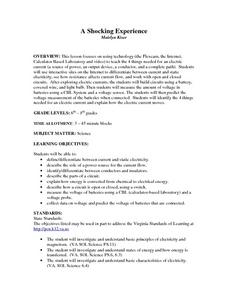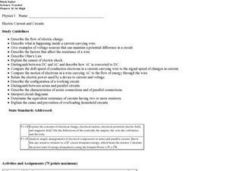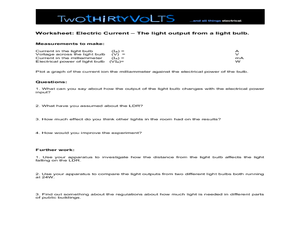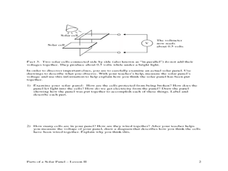Institute of Electrical and Electronics Engineers
Get Connected with Ohm's Law
Ideal for your electricity unit, especially with middle schoolers, this lesson plan gets engineers using multimeters in electrical circuits to explore the relationships among voltage, current, and resistance. Older learners may even plot...
Bonneville
Macro-Scale Solar
There's no substitute for the power of the sun. The second of four installments of the Solar Resources Assessment unit looks at macro-scale photovoltaic (PV) technology. Future scientists first learn about PV modules with a PowerPoint...
Bonneville
Using a Multimeter to Analyze a Solar Circuit: Measuring Current and Voltage—Calculating Power and Resistance
Power to the people who understand electricity. A simple experiment teaches pupils how to set up an electric circuit that includes a solar module and how to measure voltage and current using a multimeter. They calculate power and...
Curated OER
A Shocking Experience
Learners differentiate between current and static electricity, conductors and insulators, explain how energy is converted from chemical to electrical, measure voltage of batteries, collect data on voltage, and predict voltage of...
Curated OER
Solar Kit Lesson #11 - Power Maximum: An Electrical Determination
Collaborative groups connect resistors and solar panels in series and measure electrical resistance, voltage, and current. The objective is to order 16 solar panels from strongest to weakest. They graph current-voltage and power curves...
Curated OER
Ohm's Law: Getting There Hands On
Young scientists inductively derive Ohm's Law of voltage, resistance, and current by creating series and parallel circuits with 9-volt batteries and light bulbs. A week's worth of experiments, observation, and hands-on activities are...
Carnegie Mellon University
Battery Workshop
Introduce your class to the workings and parts of a battery-operated circuit. Pairs of pupils use lemons to make batteries and measure voltage and current with a multimeter. An accompanying worksheet is used for recording values and...
Curated OER
From Sunlight to Electric Current
Learners explore concept of current in electrical circuits. They examine how energy from the sun can be used to power everyday items, including vehicles.
Curated OER
Electric Current and Circuits
Compare the drift speed of conduction electrons in a current-carrying wire to the signal speed of changes in current. They also distinguish between DC and AC and describe how AC is converted to DC.
Curated OER
Ohm's Law
If your future physicists know how to construct simple circuits, include resistors, and use a multi-meter to measure voltage, then you might employ this lesson on Ohm's law. Each lab group investigates the relationships among voltage,...
Curated OER
Electric Current: The Light Output from a Light Bulb
Students investigate the energy used by a light bulb. In this electrical energy lesson, students conduct an investigation to explain the relationship between the output of light and the electrical power used by a light bulb.
Curated OER
Electrical Current
Students describe an electrical current and the factors that determine the resistance of an object. In this electrical current lesson plan students discuss their knowledge of voltage, current and resistance.
Curated OER
Discovering Ohm's Law
Students explore the relationship of resistance, voltage, and current in series and parallel circuits using a computer model of a circuit board. They discover Ohm's Law by constructing series circuits.
Teach Engineering
Pointing at Maximum Power for PV
Following detailed directions, teams collect the voltage and current outputs of a photovoltaic cell by adjusting the resistance. Using the collected data, they determine the highest power output. Implications for weather and a large...
Bonneville
Solar Panel Data Sharing
It's important to share—especially in science. Pupils share the data on voltage, current, and resistance they recorded when they built circuits with solar cells in a previous lesson. They discuss the results with the class and consider...
Curated OER
PHYSICS LESSONS
Students study the concept of electricity, what an electric current is and its relationship between voltage and resistance.In this electrical lesson students solve problems using Ohm's law, and research alternative sources of electricity.
Curated OER
Microbe Power - Using a Winogradsky Column as a Battery
In this lesson the student demonstrate analysis of the changes taking place in the bottle as well as bdemonstrate application of the interactions happening in the bottle by applying these changes to the environment.y measuring and...
Curated OER
Solar Kit Lesson #13 Solarize a Toy
Students work in teams they select a low-power toy, game, or electrical deive to "solarize," or convert to solar power. They determine the operating voltage of their chosen device and design a solar array to provide this level of...
Curated OER
Galvanic Reactions
Students create a battery using pennies. In this galvanic reactions lesson plan, students use pennies, a washer, salt water, wires, tape and a paper towel to create a battery. They use a voltmeter to record the voltage in their battery...
Curated OER
Completing the Circuit
Students use a battery, wires, small light bulb and a light bulb holder to learn the difference between an open circuit and a closed circuit, and understand that electric current only occurs in a closed circuit. They describe the...
Curated OER
Parts of a Solar Panel-Part II
Students discover how a mini-solar panel is constructed by behaving like detectives. Students examine an actual solar panel, measure the solar panel's voltage and use drawings to describe what they observe before completing questions...
Cornell University
Characterizing a Solar Cell
Young classes are sure to get a charge out of this lesson! Learners experiment with circuits of a solar cell. They practice determining current, voltage, and power for the circuit and maximize the voltage and current of the cell.
Teach Engineering
Can You Resist This?
Some things are hard to resist. Small collaborative groups build circuits and calculate the voltage using Ohm's Law. Budding engineers explore the connection between the voltage across different resistors and linear functions with...
LABScI
Circuits Lab: Lightbulbs
Electrons flow from negative to positive, but the general consensus is that current flows from positive to negative. Scholars explore current through construction of circuits in both series and parallel. The focus is on voltage,...

























